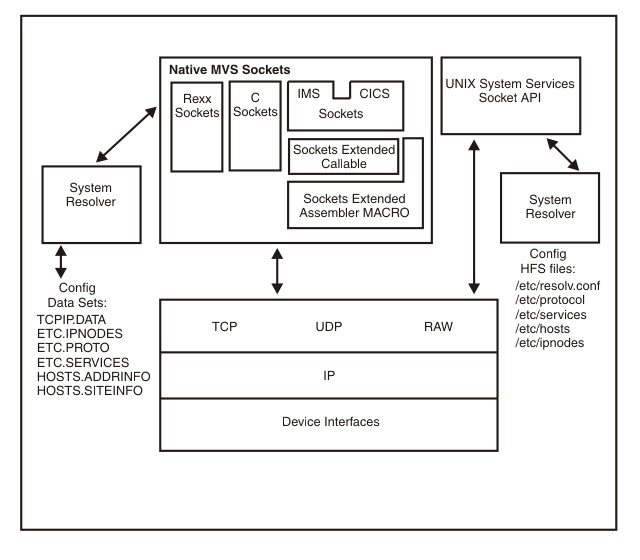Understanding the resolver search orders used in native MVS™ and z/OS® UNIX environments is key to setting up your system properly.
The resolver can use available name servers, local definitions, or a combination of both, to process API resolver requests. Figure 1 shows how local definitions can be specified and searched for when needed.
Use the trace resolver facility to determine what TCPIP.DATA values are being used by the resolver and where they were read from. For information about dynamically starting the trace, see z/OS Communications Server: IP Diagnosis Guide. After the trace is active, issue the Netstat HOME/-h command to display the values. You can issue a Ping of a host name from TSO and from the z/OS UNIX shell to show the activity to the resolver cache and to any DNS servers that might be configured.

Table 1 shows the complete set of local definition possibilities available to the resolver.
| File type description | APIs affected | Candidate files |
|---|---|---|
| Base resolver configuration files | All APIs |
|
| Translate tables | All APIs |
|
| Local host tables | endhostent |
|
| Protocol information | endprotoent |
|
| Services information | endservent |
|
| Host alias table | getaddrinfo |
HOSTALIASES environment variable |
The actual search order of the candidate files varies depending on the type of API that is used and the resolver setup. The search orders are explained in more detail in Search orders used in the z/OS UNIX environment and Search orders used in the native MVS environment. Because the resolver runs in the address space of the application, the resolver accesses the candidate files from the application address space.
Information about an application's search order can be obtained by using the trace resolver facility. Trace resolver output provides a caller API value that determines which search order is used. For information on dynamically starting the trace, see z/OS Communications Server: IP Diagnosis Guide.
The following caller API values indicate the z/OS UNIX environment search order is used:
- Language Environment® C Sockets
- UNIX System Services [z/OS UNIX System Services (z/OS UNIX) callable services]
The following caller API values indicate the native MVS environment search order is used:
- TCP/IP C Sockets
- TCP/IP Pascal Sockets
- TCP/IP Rexx Sockets
- TCP/IP Sockets Extended
The following commands are some examples of Communications Server TSO commands that use the native MVS search order:
- DIG
- FTP (batch only)Rule: Batch FTP jobs use //SYSTCPD if it is specified. If //SYSTCPD is not specified, then the z/OS UNIX search order is used.
- LPR
- NETSTAT
- NSLOOKUP
- PING
- REXEC
- RPCINFO
- RSH
- TRACERTE
The following commands are some examples of Communications Server UNIX commands that use the z/OS UNIX search order:
- dig
- dnsdomainname
- domainname
- ftpRule: The TSO FTP command also uses the z/OS UNIX search order.
- host
- hostname
- netstat
- nslookup
- ping
- rexec
- rpcinfo
- sendmail
- snmp
- traceroute
The following applications are some examples of Communications Server applications that use the native MVS search order:
- CICS® Listener
- LPD
- Miscellaneous server
- PORTMAP
- RSHD
- SMTP server
- TN3270E Telnet server
The following applications are some examples of Communications Server applications that use the z/OS UNIX search order:
- CSSMTP
- FTP
- SNMP agent
- z/OS UNIX OPORTMAP
- z/OS UNIX OREXECD
- z/OS UNIX ORSHD